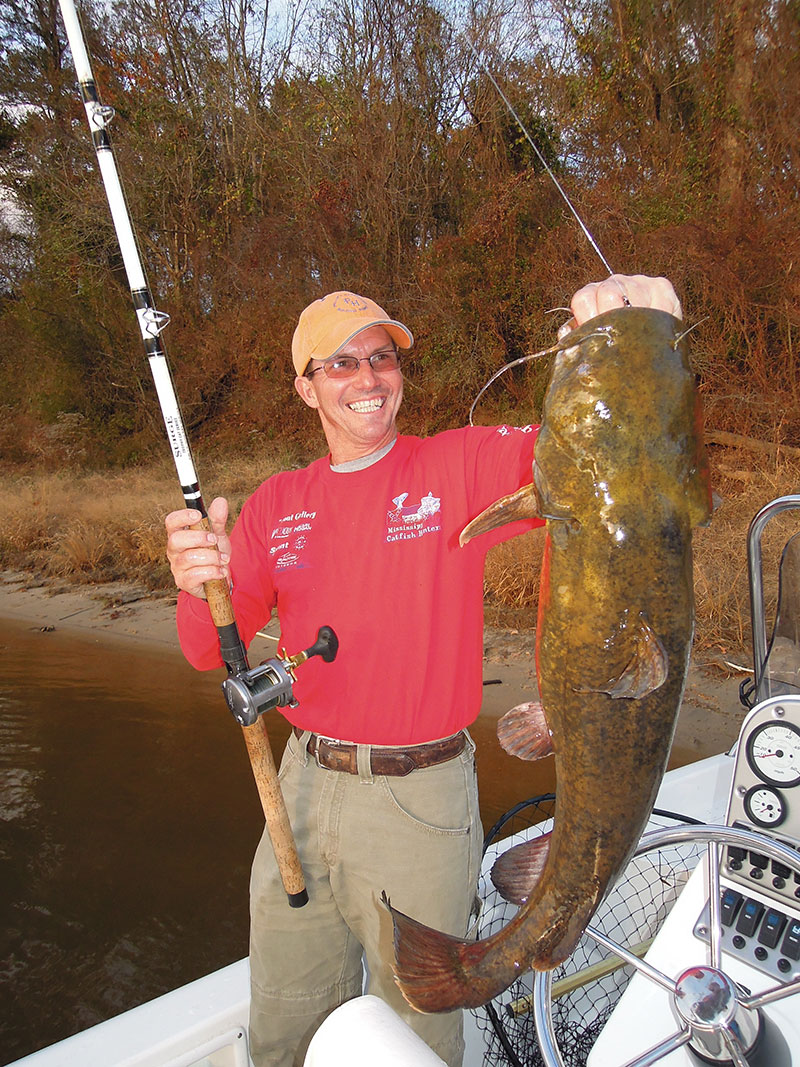
Patience, skill and luck needed to challenge huge river system catfish
The clicker on the deep-sea reel ticked a couple times as the tip of the stout big-game rod began to dance. About 80 feet straight down, the live baitfish weighing about a pound, grew nervous. Moments later, the reel began screeching as a huge fish engulfed the baitfish and took off with it.
Louisiana offers anglers outstanding offshore and blue-water fishing, but this trip took place in brown river water where a huge blue catfish inhaled that bait. Not everyone can afford an offshore trip, but anglers can usually find “big-game” fishing action close to home for considerably less cost.
“Catfish is an underutilized resource throughout Louisiana,” stated Brian J. Heimann, a Louisiana Department of Wildlife and Fisheries biologist in Baton Rouge. “All the big rivers throughout Louisiana hold many big blue and flathead catfish as well as channel cats. When we do fish population sampling in the big rivers, we notice a lot of large catfish with some in the 30- to 50-pound range, especially in the Mississippi River.”
Lawson Boyte set the Louisiana state record for blue cats at 114 pounds in March 2014. He pulled it from the Mississippi River in East Carroll Parish. Roland Lasseigne landed a record 95-pound flathead in July 2007. That fish came from Wax Lake in the lower Atchafalaya River system.
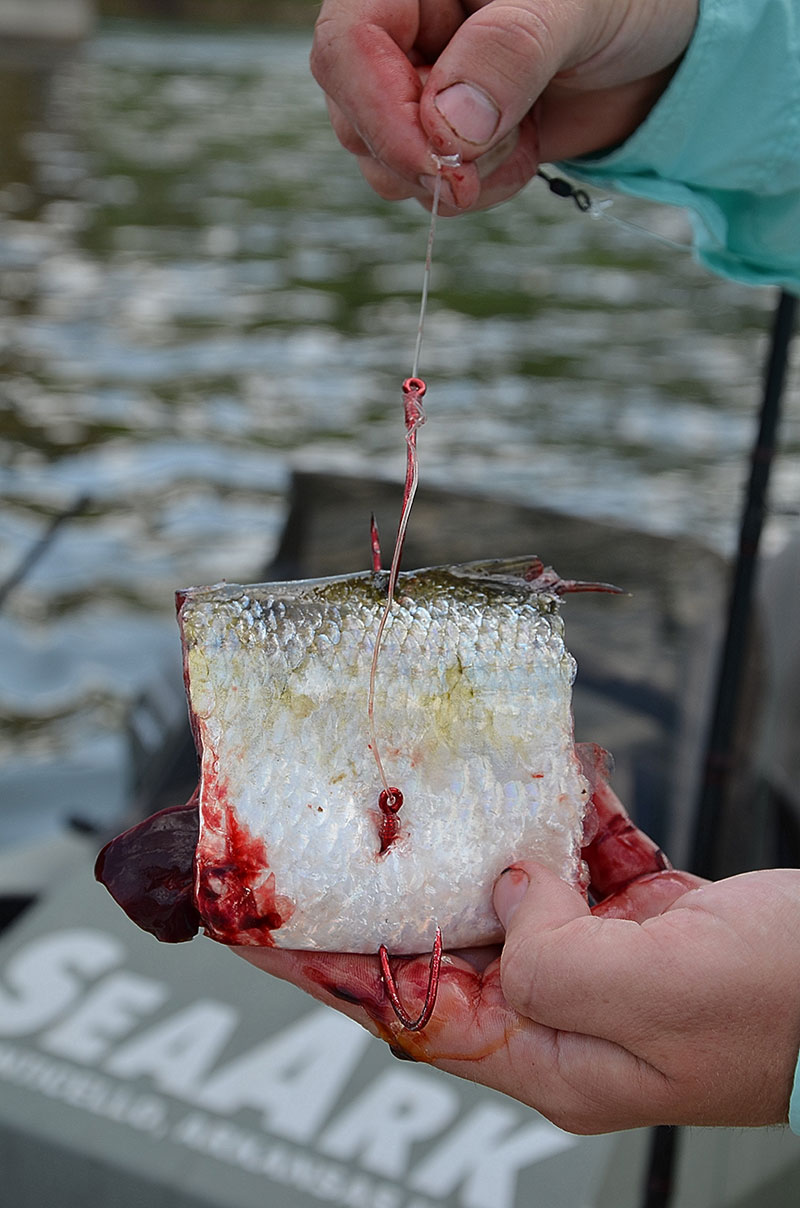
In Mississippi, Christopher Halley established the record for blue catfish at 104 pounds in August 2022. It came out of the Mississippi River. Mark Wilkerson tops the state flathead list with an 89.5-pounder caught in the Yazoo River in April 2018.
“The Mississippi River has some giant catfish with many over 100 pounds, but it’s a big, intimidating river to fish,” Heimann said. “In 2005, an angler caught a 110-pound blue catfish in the Mississippi River at Baton Rouge. We aged it at 17 years old. Many people think catfish live a lot longer than they do. The oldest catfish I’ve ever personally aged was a big 18-year-old flathead. About 12 to 15 years is the average lifespan for catfish.”
Patience, skill and luck
People occasionally catch massive catfish by accident, but targeting trophy whiskerfish requires patience, skill and considerable luck! Those who consistently catch river monsters deliberately fish for them in waters known to produce giants.
Lee Ray Rhodes from Georgetown fished for catfish all his life. Lee didn’t quite crack in the 100-pound club, but he came very close with a 98-pound blue he caught while fishing at Lock 4 on the Red River. Also on the Red River, he landed a 72-pound flathead near Montgomery.
“In 2022, I caught 29 catfish over 50 pounds,” he said. “In my opinion, the Red River is one of the best rivers in the nation for big catfish. People catch many big catfish off the bank behind the locks on the Red River. I also fish the Ouachita River and caught a good many big catfish in it.”
To catch big catfish, people must first find them. Few catfish reach or exceed 50 pounds. Even fewer top 100.
“To catch really big catfish, anglers must spend considerable time on the water specifically fishing for big catfish,” said Phil King, a professional catfish angler from Corinth, Miss., with multiple national championship titles to his credit. “The key to catching catfish is getting the bait in front of its nose. Catfish like places where they feel secure, but also where they can easily grab a meal if something comes by. I like to fish right along the drop-off edge where the current rides over the top, creating a little boil.”
Many river bottoms resemble an old washboard as currents over the centuries carved humps and valleys. Water travels faster around the outside of a bend, scouring holes. Big cats don’t like direct current, but frequently hang behind current breaks. Look for eddies or any changes in the current seam. With quality electronics, scan for drop-offs, sunken trees, humps and depth changes, anything that breaks the current. Even a 1-foot depth change could hold a massive whiskerfish.
When he finds a good spot, Rhodes anchors upriver. He puts the bait just upstream of the honey hole so the current carries the scent downriver. When actively feeding, catfish lurk just below the upstream rim of a depression waiting to pounce on anything carried by the current. Rhodes will fish a spot for about 20 minutes. If nothing happens, he moves elsewhere.
Try drifting
To cover maximum tracts of water, many anglers drift down rivers as baits bounce along the bottom. Drifting greatly increases the odds of putting a succulent morsel close to a trophy catfish. When drifting a big river, face upstream and run the trolling motor just less than the current speed.
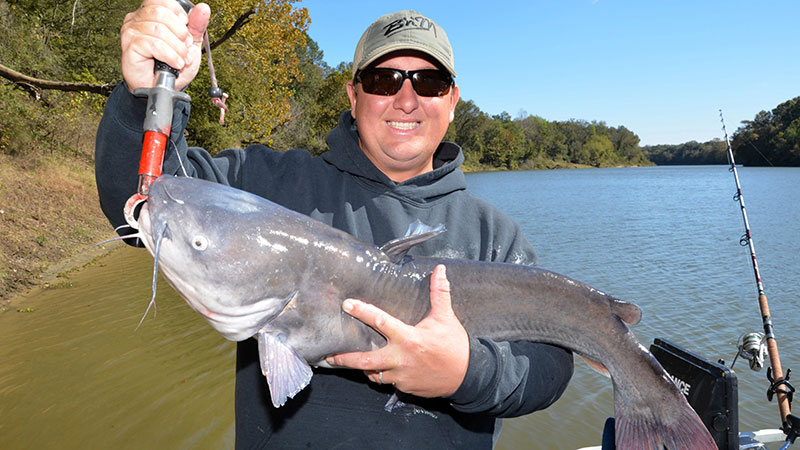
Whether anchored or drifting, don’t skimp on bait for huge cats. Giants typically want big slabs of meat. Blue catfish eat almost anything, but the biggest cats relish fish such as skipjack, gizzard shad and bluegills, alive or dead. In coastal rivers, try mullet.
“The best advice I can give to someone who wants to catch giant catfish is to upsize the bait,” King said. “Most people who don’t specifically fish for big catfish can’t believe the bait sizes we use. I’ll vary my bait throughout the day. I usually use skipjack, but in the winter, shad often works better than skipjack. I’ll start with a large bait to get the biggest fish. If that doesn’t work, I might go to a fillet and a gut section. Sometimes, they want just a chunk about an inch wide. Sometimes, they might only want live baits.”
With sensors covering its entire body, a catfish swims through the water like a huge tongue tasting everything. Nostrils detect odors down to one part in 10 billion parts of water. Thousands of taste buds per square centimeter in its skin and even more densely packed sensors in its highly developed whiskers make catfish efficient foragers.
Every living cell emits a tiny electrical field. Like something out of Star Trek, catfish also use electrosensors in their heads to detect prey. Couple that with excellent sight, acute hearing and the ability to detect sound waves almost like sonar lets catfish find food even in the darkest, muddiest waters.
Finding the flatheads
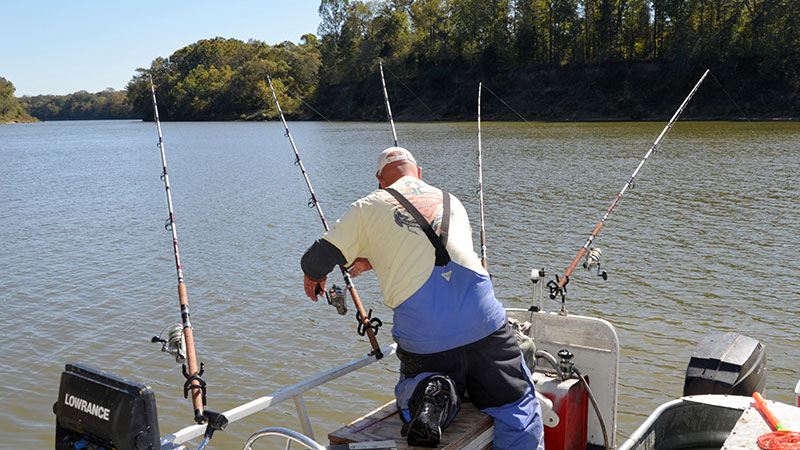
Voracious predators, flatheads almost exclusively eat live fish, typically at night. Rather than chasing enticements, large flatheads hunker down in thick cover to ambush unsuspecting prey.
“In March, flatheads become more active as water warms,” Rhodes said. “In March, I normally fish six to 10 feet deep for both blues and flatheads. For flatheads, I mainly fish eddies where the current is a little slower. I look for good drop-offs off the banks. Flatheads use high embankments like a submerged highway.”
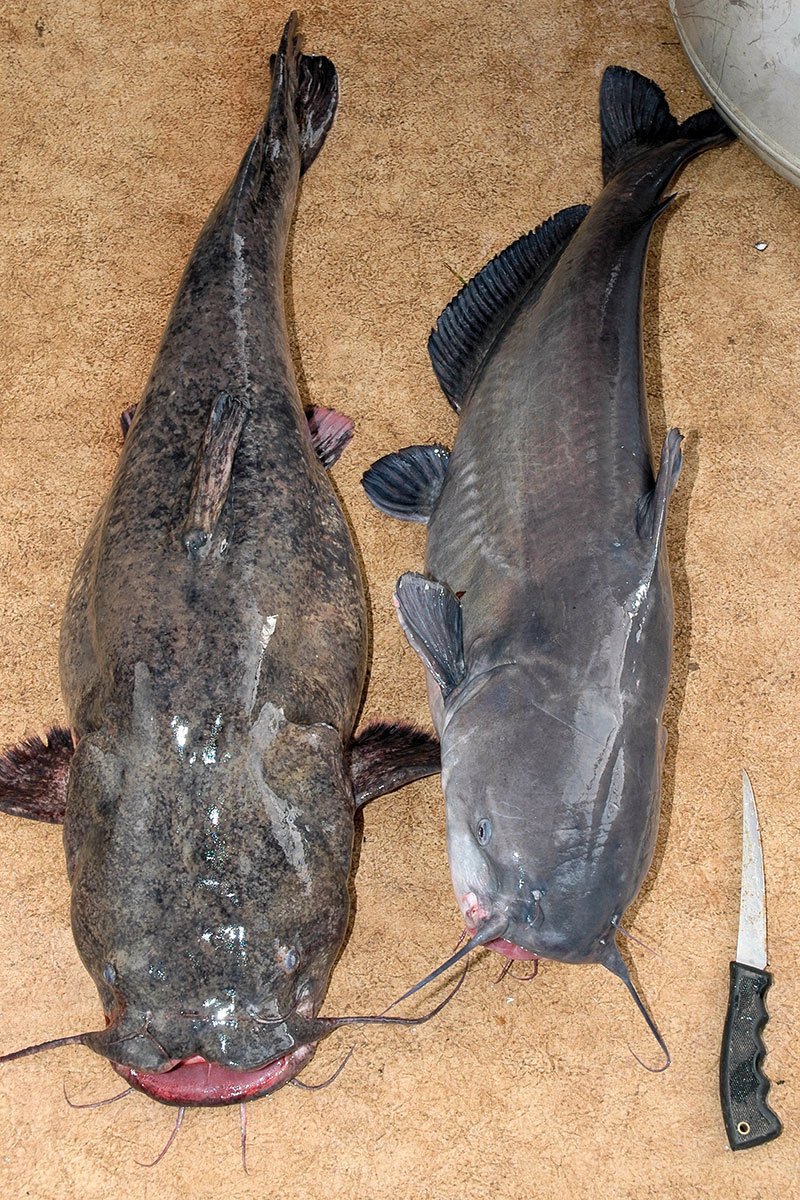
Flatheads sometimes hit fish chunks or strips. To make a strip bait, fillet off one side of a baitfish. Leave the ribcage in the fillet. Run a hook through the ribcage to give it more durability. Some anglers insert the hook once through one end of a fillet, roll it over and run the hook through it again so that the hook goes through both sides and stays on better. In the current, the meat strip undulates like a live creature.
“For flathead bait, I mainly use live bluegills or bullheads, which we call mudcats,” Rhodes said. “Mudcats are tough critters and stay alive a long time. I’ve used baits as small as a 2-inch bluegill to as big as a 1-pound mudcat. Usually, we put out six rods in holders and try several different baits at various depths to find what the fish want that day. The shallowest line might have a live bream. Deeper lines might hold cut skipjack or bluegill, a whole shad or another bait. Sometimes, we’ll cut a fillet off the fish, but leave it attached to the head with no backbone. The heads are the best part of the bait. I’ve caught more big cats on fish heads than anything else.”
Rhodes uses a Santee-Cooper rig to catch flats and blues. He ties a three-way swivel to 30-pound-test Berkley Big Game line. For the hook leader, he uses 60- to 80-pound-test. He adds a weight to the other leader. Both bait and weight leaders measure about 18 inches long.
“I don’t want a catfish’s rough teeth to fray the line and break it,” Rhodes said. “I add a small float to the hook leader to keep the bait off the bottom. I designed a cork with a bead on each end of it so it rattles under the water. That rattle helps me catch bigger fish. I normally keep the bait about 18 to 22 inches off the bottom.”
Even the most outstanding trophy catfish waters only hold so many fish. To keep more big cats in the water, it is recommended that anglers release anything over 20 pounds. People can usually catch all the smaller catfish they want to eat. And those taste much better as well. When specifically targeting river monsters, bites might come slow and far between, but any tug on a line could mean the fish of a lifetime.

